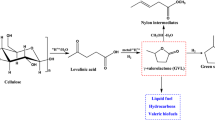Abstract
Several bifunctional catalysts (Pt, Au, Ni supported on ZSM-5, zeolite Beta, silica and alumina) were evaluated for hydrogenation of levulinic acid (LA) and γ-valerolactone (GVL). Among these, Pt supported on parent- and desilicated-zeolite Beta showed better catalytic activity for hydrogenation of gamma valerolactone to valeric acid (VA) with >98 % selectivity. Noteworthy catalytic activity of Au supported on desilicated zeolite Beta in GVL to VA hydrogenation was observed. Other catalysts such as Pt/γ-alumina, Ni/desilicated zeolite Beta and Ni/SiO2 did not exhibit significant catalytic activity in GVL hydrogenation. Pt and Au-supported zeolite catalysts were also tested for hydrogenation of LA to GVL. Pt supported on zeolites decomposed formic acid (FA) to CO2 and H2 and in situ produced H2 hydrogenated LA to GVL. Pt impregnated desilicated zeolite Beta was found to retain its integrity even after prolonged exposure to hot VA solution and neither Pt nor Al leached into solution.







Similar content being viewed by others
References
Centi G, Lanzafame P, Perathoner S (2011) Analysis of the alternative routes in the catalytic transformation of lignocellulosic materials. Catal Today 167:14–30
Serrano-Ruiz JC, Pineda A, Balu AM, Luque R, Campelo JM, Romero AA, Ramos-Fernandez JM (2012) Catalytic transformations of biomass-derived acids into advanced biofuels. Catal Today 195:162–168
Serrano-Ruiz JC, Braden DJ, West RM, Dumesic JA (2010) Conversion of cellulose to hydrocarbon fuels by progressive removal of oxygen. Appl Catal B Environ 100:184–189
Stefanidis SD, Kalogiannis KG, Iliopoulou EF, Lappas AA, Pilavachi PA (2011) In-situ upgrading of biomass pyrolysis vapors: catalyst screening on a fixed bed reactor. Bioresour Technol 102:8261–8267
Lange J, Price R, Ayoub PM, Louis J, Petrus L, Clarke L, Gosselink H (2010) Valeric biofuels: a platform of cellulosic transportation Fuels. Angew Chem Int Ed 49:4479–4483
Buitrago-Sierra R, Serrano-Ruiz JC, Rodríguez-Reinoso F, Sepúlveda-Escribano A, Dumesic JA (2012) Ce promoted Pd–Nb catalysts for γ-valerolactone ring-opening and hydrogenation. Green Chem 14:3318–3324
Rackemann DW, Doherty WO (2011) Biofuels: the conversion of lignocellulosics to levulinic acid. Bioprod Bioref 5:115–126
Alonso DM, Wettstein SG, Dumesic JA (2013) Gamma-valerolactone, a sustainable platform molecule derived from lignocellulosic biomass. Green Chem 15:584–595
Alonso DM, Bond JQ, Dumesic JA (2010) Catalytic conversion of biomass to biofuels. Green Chem 12:1493–1513
Hayes D (2009) An examination of biorefining processes, catalysts and challenges. Catal Today 145:138–151
Wettstein SG, Alonso DM, Gurbuz EI, Dumesic JA (2012) A roadmap for conversion of lignocellulosic biomass to chemicals and fuels. Curr Opin Chem Eng 1:218–224
Chan-Thaw CE, Marelli M, Psaro R, Ravasio N, Zaccheriaa F (2013) New generation biofuels: γ-valerolactone into valeric esters in one pot. RSC Adv 3:1302–1306
Upare PP, Lee JM, Hwang DW, Halligudi SB, Hwang YK, Chang JS (2011) Selective hydrogenation of levulinic acid to g-valerolactone over carbon-supported noble metal catalysts. J Ind Eng Chem 17:287–292
Raspolli Galletti AM, Antonetti C, Ribechini E, Colombini MP, Nasso NN, Bonari E (2012) From giant reed to levulinic acid and gamma-valerolactone: a high yield catalytic route to valeric biofuels. Appl Energy 102:157–162
Braden DJ, Henao CA, Heltzel J, Maravelias CC, Dumesic JA (2011) Production of liquid hydrocarbon fuels by catalytic conversion of biomass-derived levulinic acid. Green Chem 13:1755–1765
Wettstein SG, Bond JQ, Alonso DM, Pham HN, Datye AK, Dumesic JA (2012) RuSn bimetallic catalysts for selective hydrogenation of levulinic acid to γ-valerolactone. Appl Catal B Environ 117–118:321–329
Luo W, Deka U, Beale AM, van Eck ERH, Bruijnincx PCA, Weckhuysen BM (2013) Ruthenium-catalyzed hydrogenation of levulinic acid: influence of the support and solvent on catalyst selectivity and stability. J Catal 301:175–186
Modhera BK, Chakraborty M, Bajaj HC, Parikh PA (2011) Influences of mesoporosity generation in ZSM-5 and zeolite beta on catalytic performance during n-hexane isomerization. Catal Lett 141:1182–1190
Curtis Conner Jr W, Falconer JL (1995) Spillover in heterogeneous catalysis. Chem Rev 95:759–788
Corma A, Serna P (2006) Chemoselective hydrogenation of nitro compounds with supported gold catalysts. Science 313:332–334
Riahi G, Guillemot D, Polisset-Thfoin M, Khodadadi AA, Fraissard J (2002) Preparation, characterization and catalytic activity of gold-based nanoparticles on HY zeolites. Catal Today 72:115–121
Caillot T, Gauthier G, Delichère P, Cayron C, Cadete Santos Aires FJ (2012) Evidence of anti-coking behaviour of La0.8Sr0.2Cr0.98Ru0.02O3as potential anode material for solid oxide fuel cells directly fed under methane. J Catal 290:158–164
Batalha N, Pinard L, Pouilloux Y, Guisnet M (2013) Bifunctional hydrogenating /acid catalysis: quantification of the intimacy criterion. Catal Lett 143(6):587–591
Yu WA, Mullen GM, Mullins CB (2013) Hydrogen adsorption and absorption with Pd−Au bimetallic surfaces. J Phys Chem C 117:19535–19543, and references therein
Bond JQ, Wang D, Alonso DM, Dumesic JA (2011) Interconversion between γ-valerolactone and pentenoic acid combinedwith decarboxylation to form butene over silica/alumina. J Catal 281:290–299
Bond JQ, Alonso DM, Wang D, West RM, Dumesic JA (2010) Integrated catalytic conversion of gamma-valerolactone to liquid alkenes for transportation fuels. Science 327:1110–1114
Palkovits R (2010) Cellulosic Biofuels. Angew Chem Int Ed 49:4336–4338
Palkovits R (2013) Personal communication
Hengne AM, Rode CV (2012) Cu–ZrO2 nanocomposite catalyst for selective hydrogenation of levulinic acid and its ester to γ-valerolactone. Green Chem 14:1064–1072
Yan ZP, Lin L, Liu SJ (2009) Synthesis of γ-valerolactone by hydrogenation of biomass-derived levulinic acid over ru/c catalyst. Energy Fuel 23:3853–3858
Li DJ, Lai DM, Fu Y, Guo QX (2009) Catalytic conversion of biomass-derived carbohydrates into γ-valerolactone without using an external H2 supply. Angew Chem Int Ed 48:6529–6532
Hengne AM, Biradar NS, Rode CV (2012) Surface species of supported ruthenium catalysts in selective hydrogenation of levulinic esters for bio-refinery application. Catal Lett 142:779–787
Bozell JJ (2010) Connecting biomass and petroleum refining with a chemical bridge. Science 329:522–523
Acknowledgments
Authors thank Prof. Dr. Regina Palkovits for helping with reaction mechanism. Further, they are indebted to Dr. CV Rode, NCL, Pune, India for many useful suggestions and ammonia TPD results and IIT Bombay, Mumbai for the ICP analyses.
Author information
Authors and Affiliations
Corresponding author
Rights and permissions
About this article
Cite this article
Derle, S.N., Parikh, P.A. Hydrogenation of levulinic acid and γ-valerolactone: steps towards biofuels. Biomass Conv. Bioref. 4, 293–299 (2014). https://doi.org/10.1007/s13399-013-0111-5
Received:
Revised:
Accepted:
Published:
Issue Date:
DOI: https://doi.org/10.1007/s13399-013-0111-5




